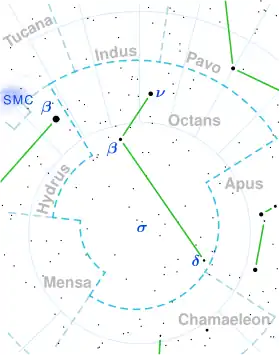HD 213402
HD 213402 (HR 8577; 73 G. Octantis) is a solitary star located in the southern circumpolar constellation Octans. It has an apparent magnitude of 6.14,[2] placing it near the limit for naked eye visibility. The object is located relatively far at a distance of 920 light-years based on Gaia DR3 parallax measurements,[1] but it is drifting closer with a heliocentric radial velocity of −12.8 km/s.[5] At its current distance, HD 213402's brightness is diminshed by 0.45 magnitudes due to interstellar extinction[15] and it has an absolute magnitude of −1.15.[6]
 | |
| Observation data Epoch J2000.0 Equinox J2000.0 (ICRS) | |
|---|---|
| Constellation | Octans |
| Right ascension | 22h 35m 26.52327s[1] |
| Declination | −78° 46′ 17.7049″[1] |
| Apparent magnitude (V) | 6.14±0.01[2] |
| Characteristics | |
| Evolutionary stage | red giant branch[1] |
| Spectral type | K1 III[3] |
| U−B color index | +1.35[4] |
| B−V color index | +1.38[4] |
| Astrometry | |
| Radial velocity (Rv) | −12.8±0.4[5] km/s |
| Proper motion (μ) | RA: +53.718 mas/yr[1] Dec.: −7.451 mas/yr[1] |
| Parallax (π) | 3.5469 ± 0.0256 mas[1] |
| Distance | 920 ± 7 ly (282 ± 2 pc) |
| Absolute magnitude (MV) | −1.15[6] |
| Details | |
| Mass | 1.17[7] M☉ |
| Radius | 44.5±2.3[8] R☉ |
| Luminosity | 471±8[9] L☉ |
| Surface gravity (log g) | 1.16[10] cgs |
| Temperature | 4,481±122[11] K |
| Metallicity [Fe/H] | −0.07[7] dex |
| Rotational velocity (v sin i) | <1.0[12] km/s |
| Other designations | |
| Database references | |
| SIMBAD | data |
HD 213402 has a stellar classification of K1 III,[3] indicating that it is an evolved K-type giant. It has a comparable mass to the Sun[7] but it has expanded to 44.5 times the radius of the Sun.[8] It radiates 471 times the luminosity of the Sun[9] from its enlarged photosphere at an effective temperature of 4,481 K,[11] giving it the typical orange hue of a K-type star. Gaia DR3 stellar evolution models place it on the red giant branch and yield a larger radius of 50.9 R☉ and a higher luminosity of 825 L☉.[1] HD 213402 is slightly metal deficient with an iron abundance of [Fe/H] = −0.07 or 85% of the Sun's abundance.[7] Like many giant stars it rotates slowly, but its projected rotational velocity is too low to be measured accurately.[12]
References
- Vallenari, A.; et al. (Gaia collaboration) (2023). "Gaia Data Release 3. Summary of the content and survey properties". Astronomy and Astrophysics. 674: A1. arXiv:2208.00211. Bibcode:2023A&A...674A...1G. doi:10.1051/0004-6361/202243940. S2CID 244398875. Gaia DR3 record for this source at VizieR.
- Høg, E.; Fabricius, C.; Makarov, V. V.; Urban, S.; Corbin, T.; Wycoff, G.; Bastian, U.; Schwekendiek, P.; Wicenec, A. (March 2000). "The Tycho-2 catalogue of the 2.5 million brightest stars". Astronomy and Astrophysics. 355: L27–L30. Bibcode:2000A&A...355L..27H. ISSN 0004-6361. S2CID 17128864.
- Houk, N.; Cowley, A. P. (1975). University of Michigan Catalogue of two-dimensional spectral types for the HD stars: Declinations −90° to −53°. Vol. 1. Bibcode:1975mcts.book.....H.
- Johnson, H. L.; Mitchell, R. I.; Iriarte, B.; Wisniewski, W. Z. (1966). "UBVRIJKL Photometry of the Bright Stars". Communications of the Lunar and Planetary Laboratory. 4: 99–110. Bibcode:1966CoLPL...4...99J.
- Gontcharov, G. A. (November 2006). "Pulkovo Compilation of Radial Velocities for 35,495 Hipparcos stars in a common system". Astronomy Letters. 32 (11): 759–771. arXiv:1606.08053. Bibcode:2006AstL...32..759G. doi:10.1134/S1063773706110065. eISSN 1562-6873. ISSN 1063-7737. S2CID 119231169.
- Anderson, E.; Francis, Ch. (May 2012). "XHIP: An extended hipparcos compilation". Astronomy Letters. 38 (5): 331–346. arXiv:1108.4971. Bibcode:2012AstL...38..331A. doi:10.1134/S1063773712050015. eISSN 1562-6873. ISSN 1063-7737. S2CID 119257644.
- Anders, F.; et al. (August 2019). "Photo-astrometric distances, extinctions, and astrophysical parameters for Gaia DR2 stars brighter than G = 18". Astronomy & Astrophysics. 628: A94. arXiv:1904.11302. Bibcode:2019A&A...628A..94A. doi:10.1051/0004-6361/201935765. eISSN 1432-0746. ISSN 0004-6361. S2CID 131780028.
- Kervella, P.; Thévenin, F.; Di Folco, E.; Ségransan, D. (April 8, 2004). "The angular sizes of dwarf stars and subgiants: Surface brightness relations calibrated by interferometry". Astronomy & Astrophysics. 426 (1): 297–307. arXiv:astro-ph/0404180. Bibcode:2004A&A...426..297K. doi:10.1051/0004-6361:20035930. eISSN 1432-0746. ISSN 0004-6361.
- Brown, A. G. A.; et al. (Gaia collaboration) (August 2018). "Gaia Data Release 2: Summary of the contents and survey properties". Astronomy & Astrophysics. 616. A1. arXiv:1804.09365. Bibcode:2018A&A...616A...1G. doi:10.1051/0004-6361/201833051. Gaia DR2 record for this source at VizieR.
- McDonald, I.; Zijlstra, A. A.; Watson, R. A. (15 June 2017). "Fundamental parameters and infrared excesses of Tycho–Gaia stars". Monthly Notices of the Royal Astronomical Society. 471 (1): 770–791. arXiv:1706.02208. Bibcode:2017MNRAS.471..770M. doi:10.1093/mnras/stx1433. eISSN 1365-2966. ISSN 0035-8711. S2CID 73594365.
- Stassun, Keivan G.; et al. (9 September 2019). "The Revised TESS Input Catalog and Candidate Target List". The Astronomical Journal. 158 (4): 138. arXiv:1905.10694. Bibcode:2019AJ....158..138S. doi:10.3847/1538-3881/ab3467. eISSN 1538-3881. hdl:1721.1/124721. S2CID 166227927.
- De Medeiros, J. R.; Alves, S.; Udry, S.; Andersen, J.; Nordström, B.; Mayor, M. (January 2014). "A catalog of rotational and radial velocities for evolved stars V: Southern stars *". Astronomy & Astrophysics. 561: A126. arXiv:1312.3474. Bibcode:2014A&A...561A.126D. doi:10.1051/0004-6361/201220762. eISSN 1432-0746. ISSN 0004-6361. S2CID 54046583.
- Gould, Benjamin Apthorp (1878). "Uranometria Argentina : brillantez y posicion de las estrellas fijas, hasta la septima magnitud, comprendidas dentro de cien grados del polo austral : con atlas". Resultados del Observatorio Nacional Argentino. 1. Bibcode:1879RNAO....1.....G.
- "HD 213402". SIMBAD. Centre de données astronomiques de Strasbourg. Retrieved October 8, 2023.
- Gontcharov, George A.; Mosenkov, Aleksandr V. (28 September 2017). "Verifying reddening and extinction for Gaia DR1 TGAS main sequence stars". Monthly Notices of the Royal Astronomical Society. 472 (4): 3805–3820. arXiv:1709.01160. Bibcode:2017MNRAS.472.3805G. doi:10.1093/mnras/stx2219. eISSN 1365-2966. ISSN 0035-8711. S2CID 118879856.